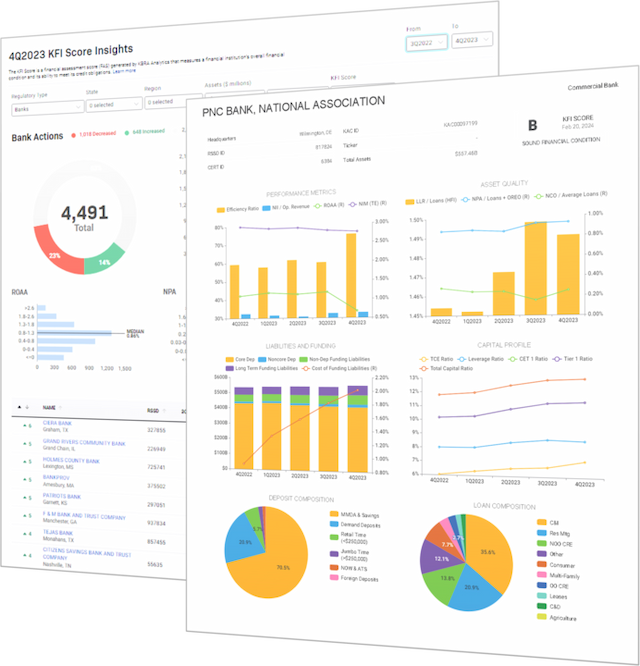KBRA Financial Intelligence
Bank Layoffs Surge to Fastest Rate Since 2009 While Credit Union Workforce Expands
By KFI Staff
Banks Slash Jobs Amid Margin Compression, Tech Disruption
In January, Ally Financial (KFI Score: B-) cut nearly 5% of its 11,000 employees. Meanwhile, Citigroup (KFI Score: B+) continued reducing its workforce, part of a previously announced plan to cut 20,000 jobs—equivalent to roughly 8% of its 2024 workforce—by the end of 2026. Although these reductions may appear modest on their own, they reflect a broader and sustained trend within the U.S. commercial banking sector.

KFI data show that commercial bank headcount (which includes savings banks and savings and loan associations for this analysis) slumped to a three-year low in 3Q 2024. The net decline from peak headcount in 1Q 2023 was equivalent to almost 74,000 employees. On a percentage basis, the year-over-year (YoY) fall in commercial bank staff levels in 2024 accelerated to its fastest rate since 2009. To access KFI’s full library of data covering nearly 10,000 banks and credit unions, request a demo here.
While the rate of decline is similar, the recent workforce reductions differ significantly in context from the hiring collapse that followed the global financial crisis. Workforce reductions are likely driven by cost-cutting measures in response to sustained net interest margin (NIM) compression over recent years. Data from the FDIC’s quarterly banking report indicates that loan yields increased at a faster rate than the change in deposit costs in just two quarters out of the past seven. Though banks have generally remained profitable for most of that period, the longest-ever inversion of the U.S. yield curve has pressured banks to reduce costs, where possible, to continue attracting increasingly expensive funding for new loans. For many banks, that meant streamlining operations and reducing overhead to remain competitive.

Though many banks have cut headcount alongside a reduction in their total assets, others have slashed jobs while also growing their asset size. In fact, the average increase in assets across all U.S. commercial banks throughout the first three quarters of 2024 was equivalent to about 3.8%, suggesting that many banks are likely reducing costs and inefficiencies within their workforces while maintaining growth. Part of this trend could be tied up in expectations about economic growth in the future or technological advances. According to Bloomberg Intelligence, global banks may eliminate up to 200,000 positions over the next three to five years via the adoption of artificial intelligence (AI). As an example, a 2024 Citigroup report projected that AI could displace more jobs across the banking industry than in any other sector, noting that about 54% of banking jobs have a high potential to be automated. Citi's recent layoffs reportedly affected a team focused on compiling client data and analysis—a process the bank identified as optimizable through “cluster analysis with machine learning algorithms,” according to its AI report.
U.S. Credit Union Staffing Climbs to All-Time High
While banks have been focused on shrinking their workforces, U.S. credit union (CU) full-time headcount has risen to all-time highs. As of 3Q 2024, CU employees numbered almost 347,000, representing less than one-fifth of the nation’s 2.1 million commercial bank employees, but experiencing an increase of 10% throughout the past three years of data. During the same period, total credit union loans increased by one-third, more than double the 16% growth rate of total commercial bank loans, indicating that the divergence in headcount correlates with persistently stronger growth in lending assets held by credit unions.

One factor is the rate advantages offered by credit unions, particularly as the Federal Reserve aggressively tightened monetary policy in 2022-23. Though CUs generally offer fewer products compared to their commercial bank counterparts, these lenders typically pay higher rates to depositors and offer lower rates to their borrowers, which becomes a particularly attractive proposition when rates surge and consumers are likely to become more sensitive to their expenditures on interest payments. A CUInsight analysis spanning four decades of data between 1980 and 2020 found that periods of higher rates on deposits demonstrated a “strong positive impacts on asset size growth.” Credit unions that increased interest rates on deposits by 1% more than banks achieved asset growth rates that were 2.2% higher on average.

While the headcount and asset growth boom among CUs appears to have peaked, elevated short-term rates may continue to attract deposits, enabling further asset expansion. As KFI noted in December, recent trends in banks’ debt issuance suggest that many financial institutions expect higher long-term rates in 2025. If this plays out, ongoing yield curve steepening could continue, generally benefiting lending conditions for banks and credit unions alike.
